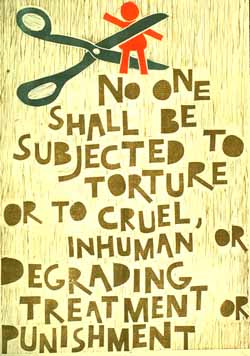“The healthy man does not torture others – generally it is the tortured who turn into torturers”
Carl Jung
I completely agreed with Emma, Amie and Tamaryn’s posts on Torture, concluding that torture in an unacceptable practice and in violation of Human Rights.
Tony discussed the implications and use of torture by physiotherapists, a side of this topic that I didn’t even think of when I wrote my original post. What about when a physiotherapist is causing unintentional pain and discomfort to an uncooprative bedridden patient with Alzheimers and Dementia with contractures and bedsores. Let’s say this patient is not “compos mentis” and their family (right of attorney and legal guardian) have agreed to therapy as prescribed by her physician. Now this patient is refusing any touch or movement…. If you stretch or mobilise her and it hurts, or she communicates that are you causing her pain just by touching her skin and she is refusing to do any movements or exercises, is this torture? If you move her and she screams, and you continue with the stretches, although you know this pain perception is abnormal due to her cognitive state, are you torturing this patient? This really made me think as most physiotherapists have been in this position. I don’t believe that this is torture as we are not deliberately trying to cause pain to obtain something from her or to teach her a lesson or just because we are sadistic and want her to suffer. We are trying to help her as a health care professional with the medical knowledge to know what physical and emotional reactions are appropriate or normal in terms of anatomical and physiological functioning. As physiotherapists we know that the discomfort felt from stiffness with light stretches or mobilising exercises or supported positional changes (without forcing into end range etc), is more “soreness”, not painful as perceived. Especially if this patient reacts with abnormal perceived pain with any touch (such as being washed, dressed, hair combed, teeth brushed etc). We are not doing any harm, but improving functional ability and preventing further damage or secondary complications through our treatment. Thus I believe in this instance we are not torturing the patient. This patient might view being washed by the nursing staff as torture, but those sound of mind know what is being done is esssential care and not harmful. If a “compos mentis” patient refuses your treatment and you go against their will and force treatment on them, or hurt them on purpose by forcing stretches beyond subjective comfort or refusing to help them when they are in pain or discomfort, that is another story. Marna also discussed this area of potential torture in patient care in her blog post.
Torture can also be seen as intentionally delaying essential care or providing minimal or refusing assistance or intervention causing a patient to remain in pain and suffer. This is also against to Hippocratic oath and the HPCSA National Health Act and Health Professions Act, to do no harm. This is what happened in the Steve Biko case I discussed in my original post. Kim also discussed this and I found the words from one of the offending medical practitioners in this case, very central to this topic of allowing or assisting with torture due to the political or social context; “a medical practitioner’s first responsibility is the well-being of his patient, and that a medical practitioner cannot subordinate his patient’s interest to extraneous considerations.” Tucker 1991
Still, torture is being used behind closed doors by police and military forces.
This is a 2013 video of the torture and violence inflicted on innocent human beings in South Africa:
What about the saying “an eye for an eye” or that a criminal such as a murderer or child rapist deserves to be violated or tortured and stripped of his Human Rights? Well, in recent weeks, Carte Blanche ran a story of men that were accused of being child rapists only to be released after 3 months in prison where they were subjected to violence and were told that they “deserve to be tortured, violated in prison and suffer a painful death” by many in the community. As there were no circumstantial evidence and forensics linking them to this, they were released and the actual guilty child rapist was identified by DNA analysis and charged. Do you even know how many innocent people go to prison for crimes they didn’t commit? This happened with another man who was “framed” by the police for allegedly killing his girlfriend, but only after spending time in prison and going through the process of appeal did the legal system prevail and found that evidence was fabricated and that he could not be linked to this murder. The court also found that the police maliciously pursued this young man and knowing that he was innocent, they tried to ruin his life. So taking Human Rights away from prisoners or saying that they deserve to be violated or tortured, can never be the right answer.
I will end off with the words by Ghandi as quoted by Jackie and Jamie-Lee:
“An eye for an eye makes the whole world blind”
_______________________________________________________________________
For PHT402 Professional Ethics Course – Week 4: Torture
